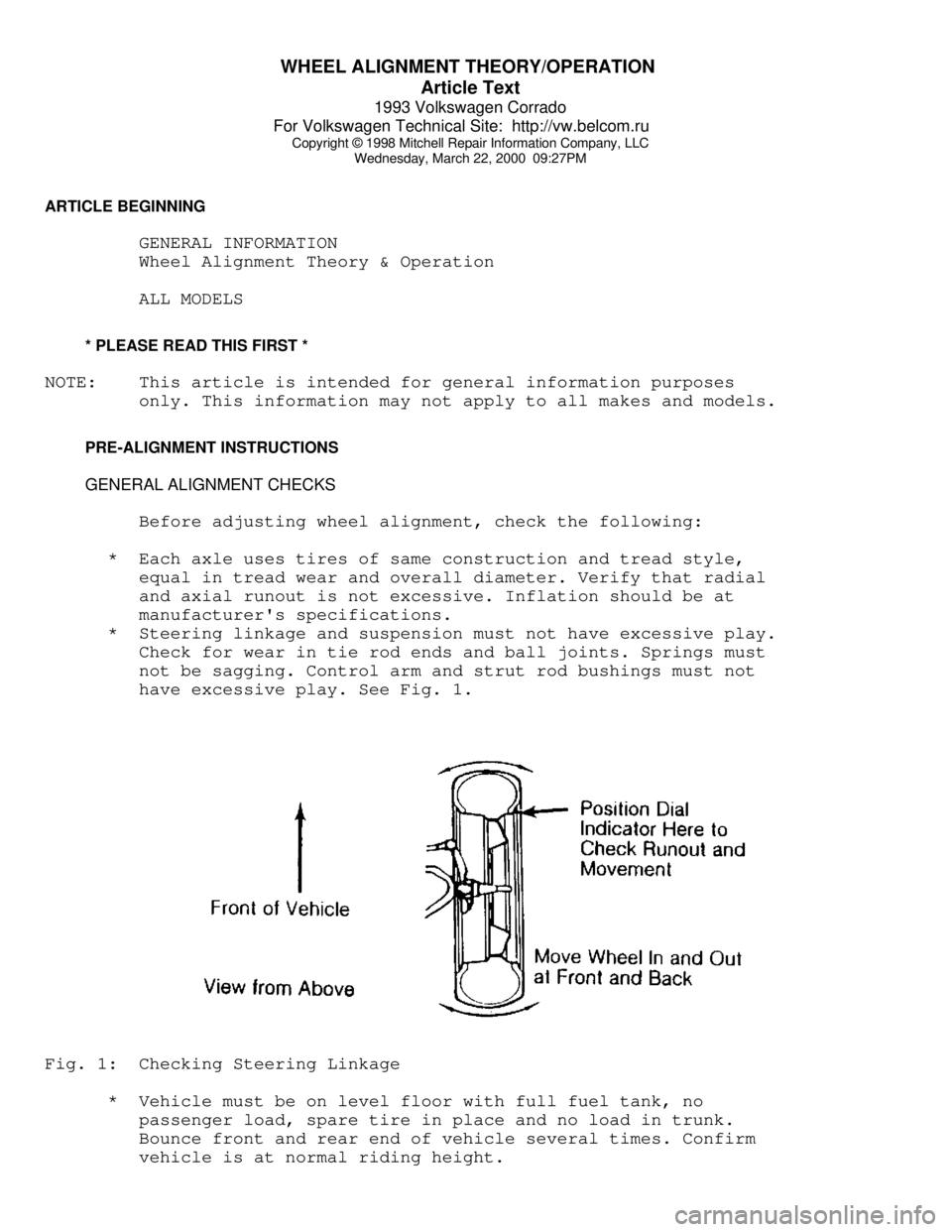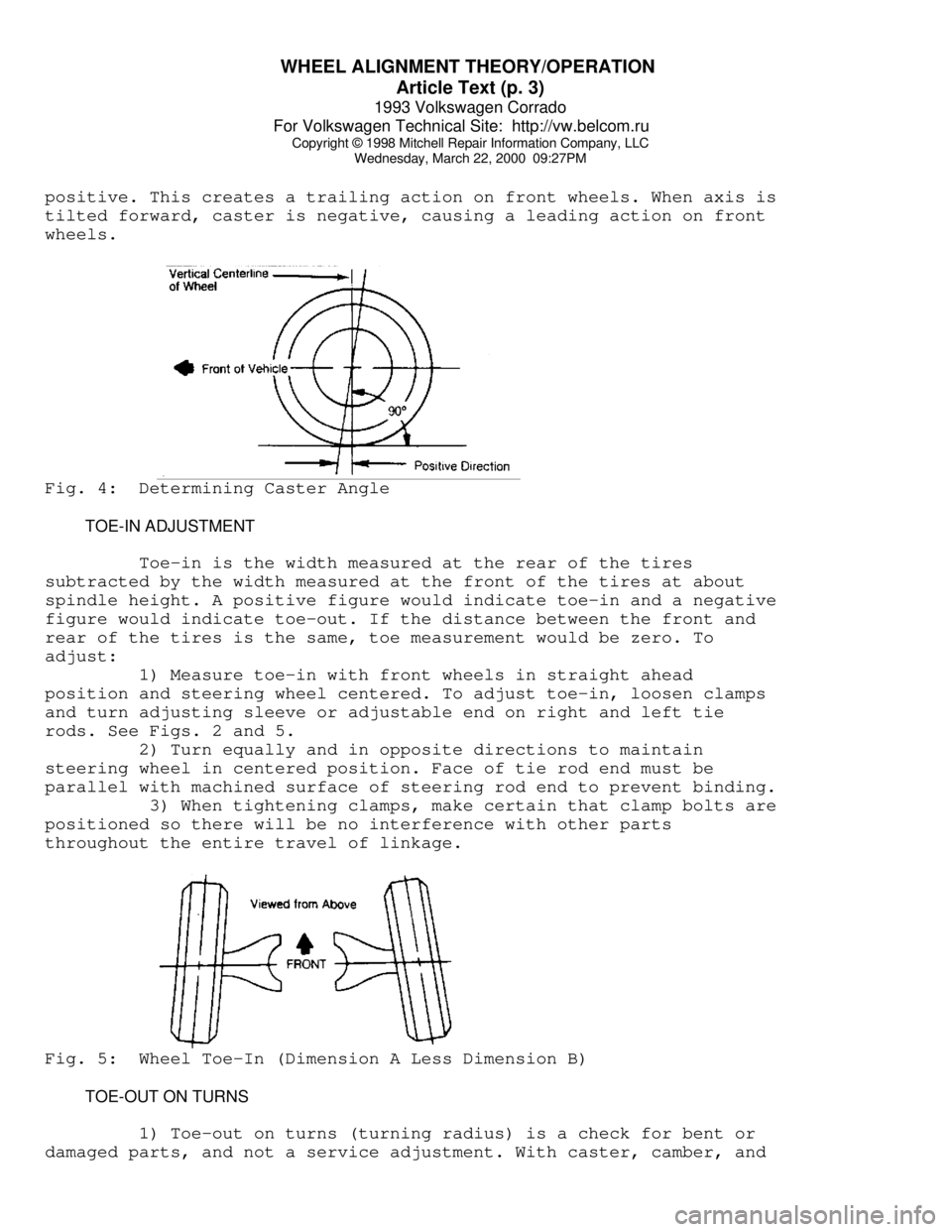1993 VOLKSWAGEN CORRADO height
[x] Cancel search: heightPage 871 of 920

WAVEFORMS - INJECTOR PATTERN TUTORIAL
Article Text (p. 12)
1993 Volkswagen Corrado
For Volkswagen Technical Site: http://vw.belcom.ru
Copyright © 1998 Mitchell Repair Information Company, LLC
Wednesday, March 22, 2000 09:26PM
controlled type drivers (explained in the next section), because they
bend upwards at this point.
How come the difference? Because of the total circuit
resistance. Voltage controlled driver circuits have a high resistance
of 12+ ohms that slows the building of the magnetic field in the
injector. Hence, no counter voltage is built up and the line remains
flat.
On the other hand, the current controlled driver circuit has
low resistance which allows for a rapid magnetic field build-up. This
causes a slight inductive rise (created by the effects of counter
voltage) and hence, the upward bend. You should not see that here with
voltage controlled circuits.
Point "D" represents the electrical condition of the injector
windings. The height of this voltage spike (inductive kick) is
proportional to the number of windings and the current flow through
them. The more current flow and greater number of windings, the more
potential for a greater inductive kick. The opposite is also true. The
less current flow or fewer windings means less inductive kick.
Typically you should see a minimum 35 volts at the top of Point "D".
If you do see approximately 35 volts, it is because a zener
diode is used with the driver to clamp the voltage. Make sure the
beginning top of the spike is squared off, indicating the zener dumped
the remainder of the spike. If it is not squared, that indicates the
spike is not strong enough to make the zener fully dump, meaning the
injector has a weak winding.
If a zener diode is not used in the computer, the spike from
a good injector will be 60 or more volts.
Point "E" brings us to a very interesting section. As you
can see, the voltage dissipates back to supply value after the peak of
the inductive kick. Notice the slight hump? This is actually the
mechanical injector pintle closing. Recall that moving an iron core
through a magnetic field will create a voltage surge. The pintle is
the iron core here.
This pintle hump at Point "E" should occur near the end of
the downward slope, and not afterwards. If it does occur after the
slope has ended and the voltage has stabilized, it is because the
pintle is slightly sticking because of a faulty injector
If you see more than one hump it is because of a distorted
pintle or seat. This faulty condition is known as "pintle float".
It is important to realize that it takes a good digital
storage oscilloscope or analog lab scope to see this pintle hump
clearly. Unfortunately, it cannot always be seen.
Page 873 of 920

WAVEFORMS - INJECTOR PATTERN TUTORIAL
Article Text (p. 14)
1993 Volkswagen Corrado
For Volkswagen Technical Site: http://vw.belcom.ru
Copyright © 1998 Mitchell Repair Information Company, LLC
Wednesday, March 22, 2000 09:26PM
injector. A good hot run voltage is usually 13.5 or more volts. This
point, commonly known as open circuit voltage, is critical because the
injector will not get sufficient current saturation if there is a
voltage shortfall. To obtain a good look at this precise point, you
will need to shift your Lab Scope to five volts per division.
You will find that some systems have slight voltage
fluctuations here. This could occur if the injector feed wire is also
used to power up other cycling components, like the ignition coil(s).
Slight voltage fluctuations are normal and are no reason for concern.
Major voltage fluctuations are a different story, however. Major
voltage shifts on the injector feed line will create injector
performance problems. Look for excessive resistance problems in the
feed circuit if you see big shifts and repair as necessary.
Point "B" is where the driver completes the circuit to
ground. This point of the waveform should be a clean square point
straight down with no rounded edges. It is during this period that
current saturation of the injector windings is taking place and the
driver is heavily stressed. Weak drivers will distort this vertical
line.
Point "C" represents the voltage drop across the injector
windings. Point "C" should come very close to the ground reference
point, but not quite touch. This is because the driver has a small
amount of inherent resistance. Any significant offset from ground is
an indication of a resistance problem on the ground circuit that needs
repaired. You might miss this fault if you do not use the negative
battery post for your Lab Scope hook-up, so it is HIGHLY recommended
that you use the battery as your hook-up.
Right after Point "C", something interesting happens. Notice
the trace starts a normal upward bend. This slight inductive rise is
created by the effects of counter voltage and is normal. This is
because the low circuit resistance allowed a fast build-up of the
magnetic field, which in turn created the counter voltage.
Point "D" is the start of the current limiting, also known as
the "Hold" time. Before this point, the driver had allowed the current
to free-flow ("Peak") just to get the injector pintle open. By the
time point "D" occurs, the injector pintle has already opened and the
computer has just significantly throttled the current back. It does
this by only allowing a few volts through to maintain the minimum
current required to keep the pintle open.
The height of the voltage spike seen at the top of Point "D"
represents the electrical condition of the injector windings. The
height of this voltage spike (inductive kick) is proportional to the
number of windings and the current flow through them. The more current
flow and greater number of windings, the more potential for a greater
inductive kick. The opposite is also true. The less current flow or
fewer windings means less inductive kick. Typically you should see a
minimum 35 volts.
If you see approximately 35 volts, it is because a zener
diode is used with the driver to clamp the voltage. Make sure the
beginning top of the spike is squared off, indicating the zener dumped
the remainder of the spike. If it is not squared, that indicates the
spike is not strong enough to make the zener fully dump, meaning there
Page 896 of 920

WHEEL ALIGNMENT THEORY/OPERATION
Article Text
1993 Volkswagen Corrado
For Volkswagen Technical Site: http://vw.belcom.ru
Copyright © 1998 Mitchell Repair Information Company, LLC
Wednesday, March 22, 2000 09:27PM
ARTICLE BEGINNING
GENERAL INFORMATION
Wheel Alignment Theory & Operation
ALL MODELS
* PLEASE READ THIS FIRST *
NOTE: This article is intended for general information purposes
only. This information may not apply to all makes and models.
PRE-ALIGNMENT INSTRUCTIONS
GENERAL ALIGNMENT CHECKS
Before adjusting wheel alignment, check the following:
* Each axle uses tires of same construction and tread style,
equal in tread wear and overall diameter. Verify that radial
and axial runout is not excessive. Inflation should be at
manufacturer's specifications.
* Steering linkage and suspension must not have excessive play.
Check for wear in tie rod ends and ball joints. Springs must
not be sagging. Control arm and strut rod bushings must not
have excessive play. See Fig. 1.Fig. 1: Checking Steering Linkage
* Vehicle must be on level floor with full fuel tank, no
passenger load, spare tire in place and no load in trunk.
Bounce front and rear end of vehicle several times. Confirm
vehicle is at normal riding height.
Page 898 of 920

WHEEL ALIGNMENT THEORY/OPERATION
Article Text (p. 3)
1993 Volkswagen Corrado
For Volkswagen Technical Site: http://vw.belcom.ru
Copyright © 1998 Mitchell Repair Information Company, LLC
Wednesday, March 22, 2000 09:27PM
positive. This creates a trailing action on front wheels. When axis is
tilted forward, caster is negative, causing a leading action on front
wheels.Fig. 4: Determining Caster Angle
TOE-IN ADJUSTMENT
Toe-in is the width measured at the rear of the tires
subtracted by the width measured at the front of the tires at about
spindle height. A positive figure would indicate toe-in and a negative
figure would indicate toe-out. If the distance between the front and
rear of the tires is the same, toe measurement would be zero. To
adjust:
1) Measure toe-in with front wheels in straight ahead
position and steering wheel centered. To adjust toe-in, loosen clamps
and turn adjusting sleeve or adjustable end on right and left tie
rods. See Figs. 2 and 5.
2) Turn equally and in opposite directions to maintain
steering wheel in centered position. Face of tie rod end must be
parallel with machined surface of steering rod end to prevent binding.
3) When tightening clamps, make certain that clamp bolts are
positioned so there will be no interference with other parts
throughout the entire travel of linkage.Fig. 5: Wheel Toe-In (Dimension A Less Dimension B)
TOE-OUT ON TURNS
1) Toe-out on turns (turning radius) is a check for bent or
damaged parts, and not a service adjustment. With caster, camber, and